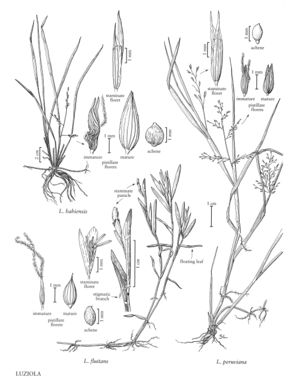Difference between revisions of "Luziola fluitans"
FNA>Volume Importer |
FNA>Volume Importer |
||
| Line 7: | Line 7: | ||
|synonyms={{Treatment/ID/Synonym | |synonyms={{Treatment/ID/Synonym | ||
|name=Hydrochloa caroliniensis | |name=Hydrochloa caroliniensis | ||
| − | |authority= | + | |authority= |
| + | |rank=species | ||
}} | }} | ||
|hierarchy=Poaceae;Poaceae subfam. Ehrhartoideae;Poaceae tribe Oryzeae;Luziola;Luziola fluitans | |hierarchy=Poaceae;Poaceae subfam. Ehrhartoideae;Poaceae tribe Oryzeae;Luziola;Luziola fluitans | ||
| Line 20: | Line 21: | ||
-->{{Treatment/Body | -->{{Treatment/Body | ||
|distribution=Ga.;Tex.;La.;Ala.;N.C.;S.C.;Ark.;Miss.;Fla. | |distribution=Ga.;Tex.;La.;Ala.;N.C.;S.C.;Ark.;Miss.;Fla. | ||
| − | |discussion=<p>Luziola fluitans grows in fresh to slightly saline lakes and streams in the southeastern United States and eastern Mexico. It is most common in the coastal plain, and also occurs in the Piedmont. Plants in the United States and eastern Mexico belong to L. fluitans (Michx.) Terrell & H. Rob var. fluitans, which differs from L. fluitans var. oconnorii (R. Guzman) G. Tucker of the uplands of central Mexico in having shorter and narrower leaf blades, shorter spikelets, and shorter anthers.</p> | + | |discussion=<p><i>Luziola fluitans</i> grows in fresh to slightly saline lakes and streams in the southeastern United States and eastern Mexico. It is most common in the coastal plain, and also occurs in the Piedmont. Plants in the United States and eastern Mexico belong to <i>L. fluitans</i> (Michx.) Terrell & H. Rob var. fluitans, which differs from <i>L. fluitans</i> var. oconnorii (R. Guzman) G. Tucker of the uplands of central Mexico in having shorter and narrower leaf blades, shorter spikelets, and shorter anthers.</p> |
|tables= | |tables= | ||
|references= | |references= | ||
| Line 29: | Line 30: | ||
-->{{#Taxon: | -->{{#Taxon: | ||
name=Luziola fluitans | name=Luziola fluitans | ||
| − | |||
|authority=(Michx.) Terrell & H. Rob. | |authority=(Michx.) Terrell & H. Rob. | ||
|rank=species | |rank=species | ||
| Line 37: | Line 37: | ||
|family=Poaceae | |family=Poaceae | ||
|illustrator=Sandy Long | |illustrator=Sandy Long | ||
| + | |illustration copyright=Utah State University | ||
|distribution=Ga.;Tex.;La.;Ala.;N.C.;S.C.;Ark.;Miss.;Fla. | |distribution=Ga.;Tex.;La.;Ala.;N.C.;S.C.;Ark.;Miss.;Fla. | ||
|reference=None | |reference=None | ||
| Line 42: | Line 43: | ||
|publication year= | |publication year= | ||
|special status= | |special status= | ||
| − | |source xml=https:// | + | |source xml=https://jpend@bitbucket.org/aafc-mbb/fna-data-curation.git/src/f50eec43f223ca0e34566be0b046453a0960e173/coarse_grained_fna_xml/V24/V24_60.xml |
|subfamily=Poaceae subfam. Ehrhartoideae | |subfamily=Poaceae subfam. Ehrhartoideae | ||
|tribe=Poaceae tribe Oryzeae | |tribe=Poaceae tribe Oryzeae | ||
Revision as of 20:22, 16 December 2019
Plants stoloniferous; mostly immersed. Culms to 1+ m, bases prostrate and rooting at the nodes. Leaves mainly cauline, usually crowded distally, streaming in the current or floating on the surface, distal leaves sometimes emergent; sheaths glabrous; ligules 0.5-2 mm, subtriangular to truncate, sometimes erose; pseudopetioles sometimes present; blades 1-5(8) cm long, 1-4 mm wide, glabrous, sometimes pilose basally, scabridulous. Inflorescences spikes or racemes, spikelets sessile or shortly pedicellate. Staminate inflorescences 1-2 cm, terminal, partially exserted from the sheaths, emergent at anthesis, with 2-4 spikelets; staminate florets 3-5 mm; lemmas narrowly ovate, usually 5-veined; paleas similar, usually 3-veined; anthers 6,2-3.7 mm, linear. Pistillate inflorescences 0.5-2 cm, mostly included in the subtending sheaths, only the stigmas visible, with 2 to few spikelets; pistillate florets 1.4-3 mm, caducous; lemmas 5-9-veined, acuminate; paleas similar to the lemmas, 3-7-veined; stigmas 3-6 mm. Achenes 1.3-2 mm, ovoid, asymmetrical, minutely striate, lustrous. 2n = 24.
Distribution
Ga., Tex., La., Ala., N.C., S.C., Ark., Miss., Fla.
Discussion
Luziola fluitans grows in fresh to slightly saline lakes and streams in the southeastern United States and eastern Mexico. It is most common in the coastal plain, and also occurs in the Piedmont. Plants in the United States and eastern Mexico belong to L. fluitans (Michx.) Terrell & H. Rob var. fluitans, which differs from L. fluitans var. oconnorii (R. Guzman) G. Tucker of the uplands of central Mexico in having shorter and narrower leaf blades, shorter spikelets, and shorter anthers.
Selected References
None.
